Week 6 Discussion: Qualitative/Quantitative Sampling & Health Data
VerifiedAdded on 2022/10/06
|7
|1402
|16
Discussion Board Post
AI Summary
This discussion post provides a comprehensive analysis of qualitative and quantitative sampling strategies in healthcare research, highlighting their advantages and disadvantages. It further examines the crucial role of data in evaluating health outcomes at both the individual work environment and national levels, emphasizing its importance in resource allocation and emergency preparedness. The post also delves into the concept of professional commitment among nurses, defining it as loyalty and dedication to the profession, even in challenging circumstances. Finally, it underscores the significance of nurses as lobbyists, advocating for policy changes that promote the welfare of nurses and improve patient care, emphasizing their potential to drive positive reforms within the healthcare sector. Desklib offers a repository of similar solved assignments and past papers for students.
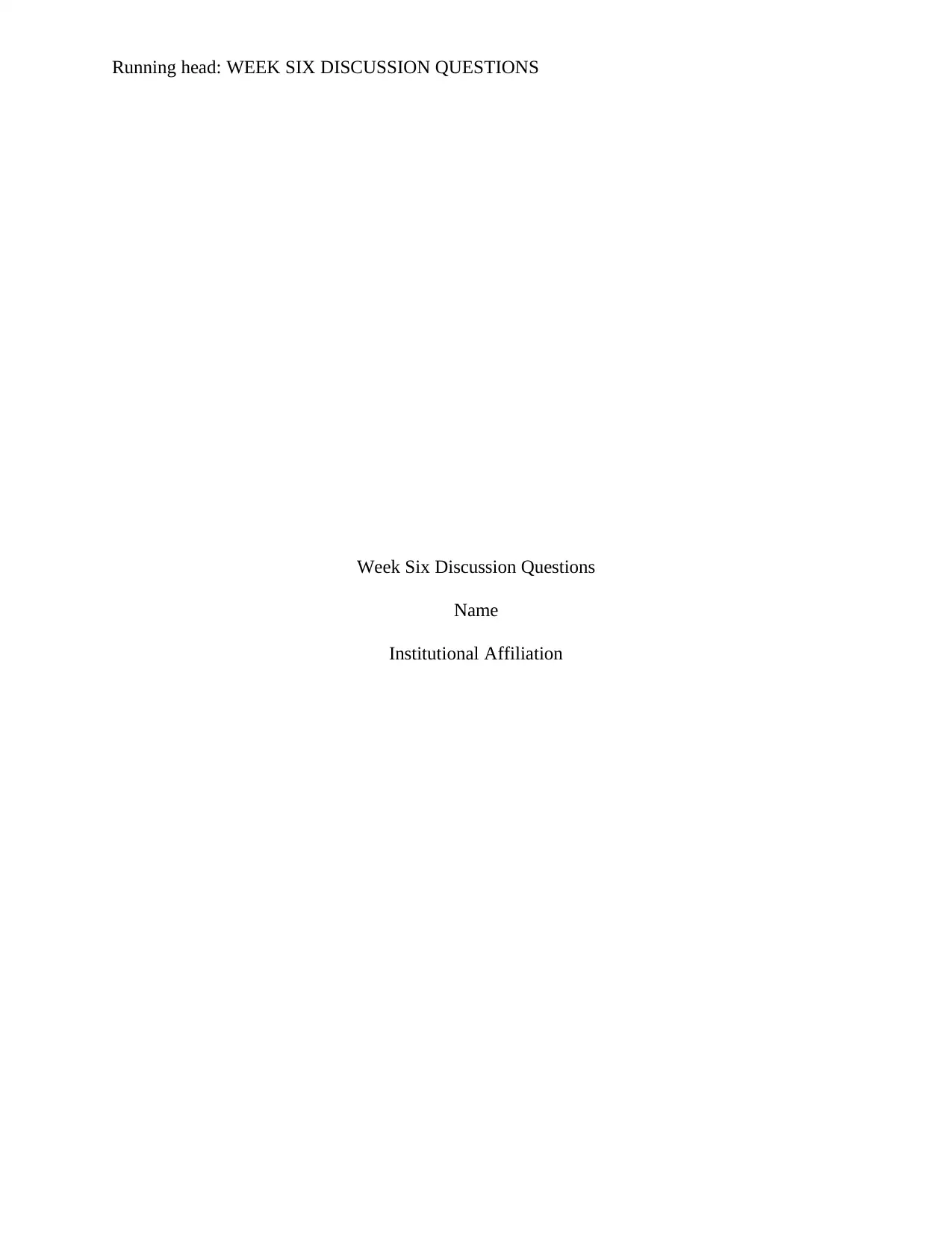
Running head: WEEK SIX DISCUSSION QUESTIONS
Week Six Discussion Questions
Name
Institutional Affiliation
Week Six Discussion Questions
Name
Institutional Affiliation
Paraphrase This Document
Need a fresh take? Get an instant paraphrase of this document with our AI Paraphraser
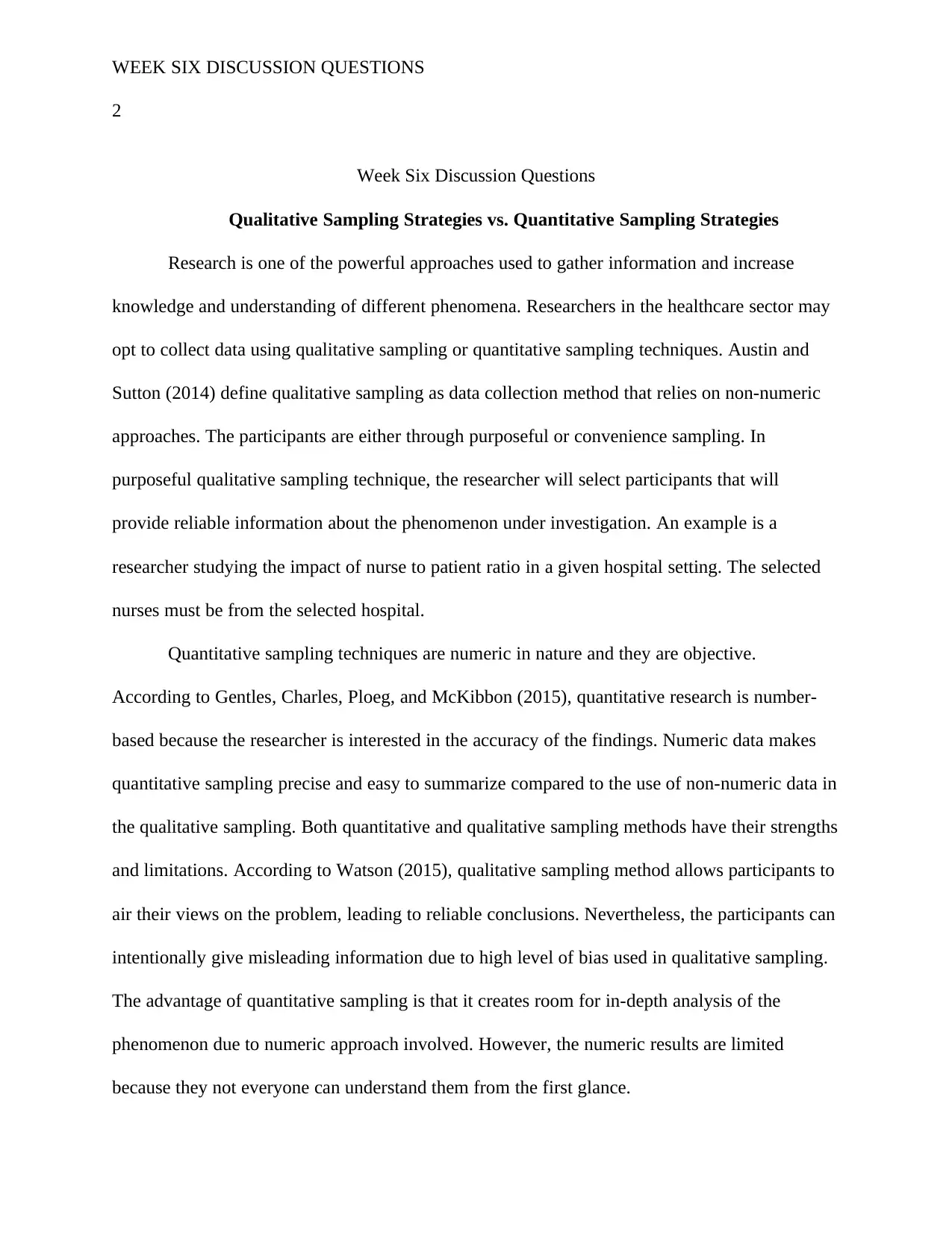
WEEK SIX DISCUSSION QUESTIONS
2
Week Six Discussion Questions
Qualitative Sampling Strategies vs. Quantitative Sampling Strategies
Research is one of the powerful approaches used to gather information and increase
knowledge and understanding of different phenomena. Researchers in the healthcare sector may
opt to collect data using qualitative sampling or quantitative sampling techniques. Austin and
Sutton (2014) define qualitative sampling as data collection method that relies on non-numeric
approaches. The participants are either through purposeful or convenience sampling. In
purposeful qualitative sampling technique, the researcher will select participants that will
provide reliable information about the phenomenon under investigation. An example is a
researcher studying the impact of nurse to patient ratio in a given hospital setting. The selected
nurses must be from the selected hospital.
Quantitative sampling techniques are numeric in nature and they are objective.
According to Gentles, Charles, Ploeg, and McKibbon (2015), quantitative research is number-
based because the researcher is interested in the accuracy of the findings. Numeric data makes
quantitative sampling precise and easy to summarize compared to the use of non-numeric data in
the qualitative sampling. Both quantitative and qualitative sampling methods have their strengths
and limitations. According to Watson (2015), qualitative sampling method allows participants to
air their views on the problem, leading to reliable conclusions. Nevertheless, the participants can
intentionally give misleading information due to high level of bias used in qualitative sampling.
The advantage of quantitative sampling is that it creates room for in-depth analysis of the
phenomenon due to numeric approach involved. However, the numeric results are limited
because they not everyone can understand them from the first glance.
2
Week Six Discussion Questions
Qualitative Sampling Strategies vs. Quantitative Sampling Strategies
Research is one of the powerful approaches used to gather information and increase
knowledge and understanding of different phenomena. Researchers in the healthcare sector may
opt to collect data using qualitative sampling or quantitative sampling techniques. Austin and
Sutton (2014) define qualitative sampling as data collection method that relies on non-numeric
approaches. The participants are either through purposeful or convenience sampling. In
purposeful qualitative sampling technique, the researcher will select participants that will
provide reliable information about the phenomenon under investigation. An example is a
researcher studying the impact of nurse to patient ratio in a given hospital setting. The selected
nurses must be from the selected hospital.
Quantitative sampling techniques are numeric in nature and they are objective.
According to Gentles, Charles, Ploeg, and McKibbon (2015), quantitative research is number-
based because the researcher is interested in the accuracy of the findings. Numeric data makes
quantitative sampling precise and easy to summarize compared to the use of non-numeric data in
the qualitative sampling. Both quantitative and qualitative sampling methods have their strengths
and limitations. According to Watson (2015), qualitative sampling method allows participants to
air their views on the problem, leading to reliable conclusions. Nevertheless, the participants can
intentionally give misleading information due to high level of bias used in qualitative sampling.
The advantage of quantitative sampling is that it creates room for in-depth analysis of the
phenomenon due to numeric approach involved. However, the numeric results are limited
because they not everyone can understand them from the first glance.
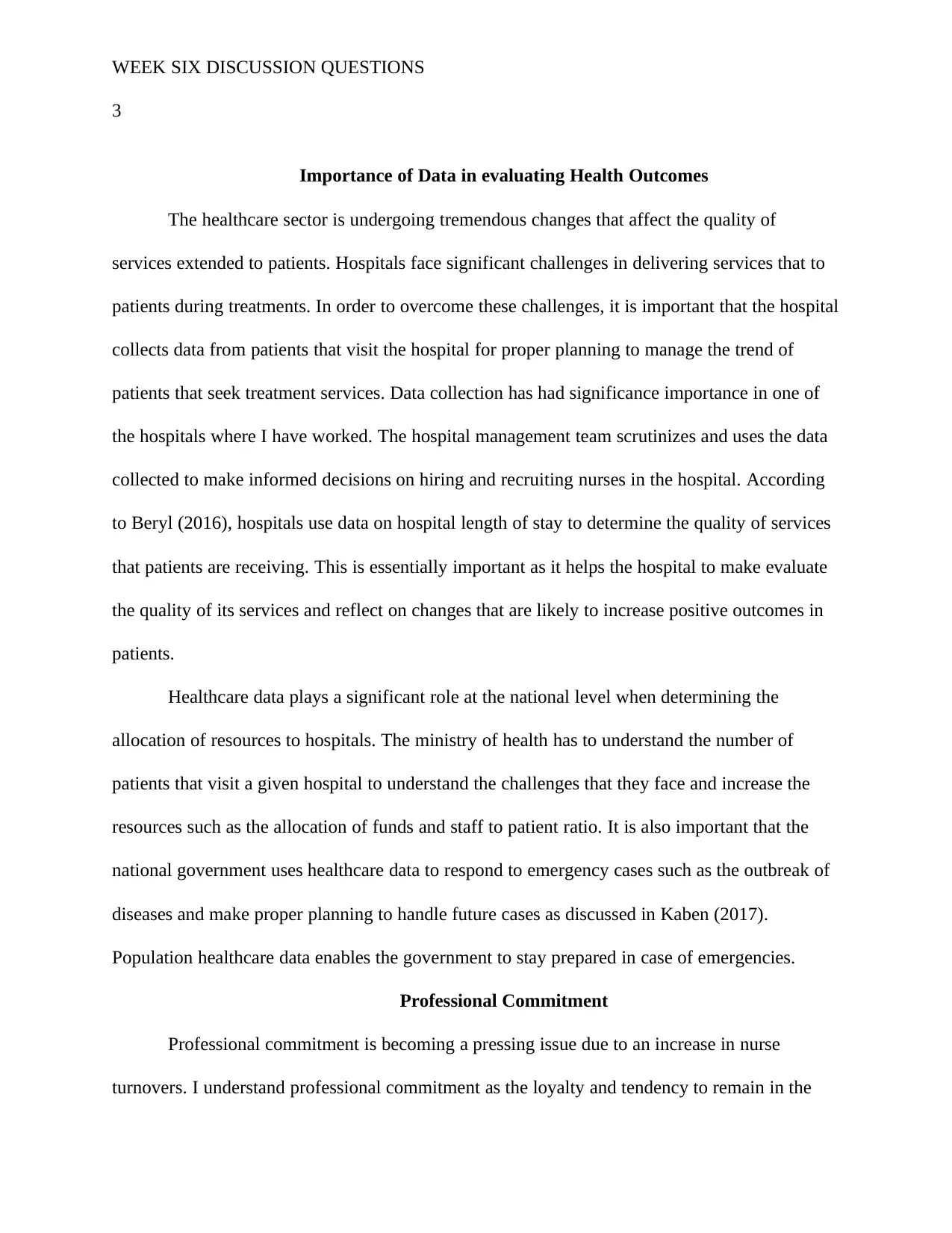
WEEK SIX DISCUSSION QUESTIONS
3
Importance of Data in evaluating Health Outcomes
The healthcare sector is undergoing tremendous changes that affect the quality of
services extended to patients. Hospitals face significant challenges in delivering services that to
patients during treatments. In order to overcome these challenges, it is important that the hospital
collects data from patients that visit the hospital for proper planning to manage the trend of
patients that seek treatment services. Data collection has had significance importance in one of
the hospitals where I have worked. The hospital management team scrutinizes and uses the data
collected to make informed decisions on hiring and recruiting nurses in the hospital. According
to Beryl (2016), hospitals use data on hospital length of stay to determine the quality of services
that patients are receiving. This is essentially important as it helps the hospital to make evaluate
the quality of its services and reflect on changes that are likely to increase positive outcomes in
patients.
Healthcare data plays a significant role at the national level when determining the
allocation of resources to hospitals. The ministry of health has to understand the number of
patients that visit a given hospital to understand the challenges that they face and increase the
resources such as the allocation of funds and staff to patient ratio. It is also important that the
national government uses healthcare data to respond to emergency cases such as the outbreak of
diseases and make proper planning to handle future cases as discussed in Kaben (2017).
Population healthcare data enables the government to stay prepared in case of emergencies.
Professional Commitment
Professional commitment is becoming a pressing issue due to an increase in nurse
turnovers. I understand professional commitment as the loyalty and tendency to remain in the
3
Importance of Data in evaluating Health Outcomes
The healthcare sector is undergoing tremendous changes that affect the quality of
services extended to patients. Hospitals face significant challenges in delivering services that to
patients during treatments. In order to overcome these challenges, it is important that the hospital
collects data from patients that visit the hospital for proper planning to manage the trend of
patients that seek treatment services. Data collection has had significance importance in one of
the hospitals where I have worked. The hospital management team scrutinizes and uses the data
collected to make informed decisions on hiring and recruiting nurses in the hospital. According
to Beryl (2016), hospitals use data on hospital length of stay to determine the quality of services
that patients are receiving. This is essentially important as it helps the hospital to make evaluate
the quality of its services and reflect on changes that are likely to increase positive outcomes in
patients.
Healthcare data plays a significant role at the national level when determining the
allocation of resources to hospitals. The ministry of health has to understand the number of
patients that visit a given hospital to understand the challenges that they face and increase the
resources such as the allocation of funds and staff to patient ratio. It is also important that the
national government uses healthcare data to respond to emergency cases such as the outbreak of
diseases and make proper planning to handle future cases as discussed in Kaben (2017).
Population healthcare data enables the government to stay prepared in case of emergencies.
Professional Commitment
Professional commitment is becoming a pressing issue due to an increase in nurse
turnovers. I understand professional commitment as the loyalty and tendency to remain in the
⊘ This is a preview!⊘
Do you want full access?
Subscribe today to unlock all pages.

Trusted by 1+ million students worldwide
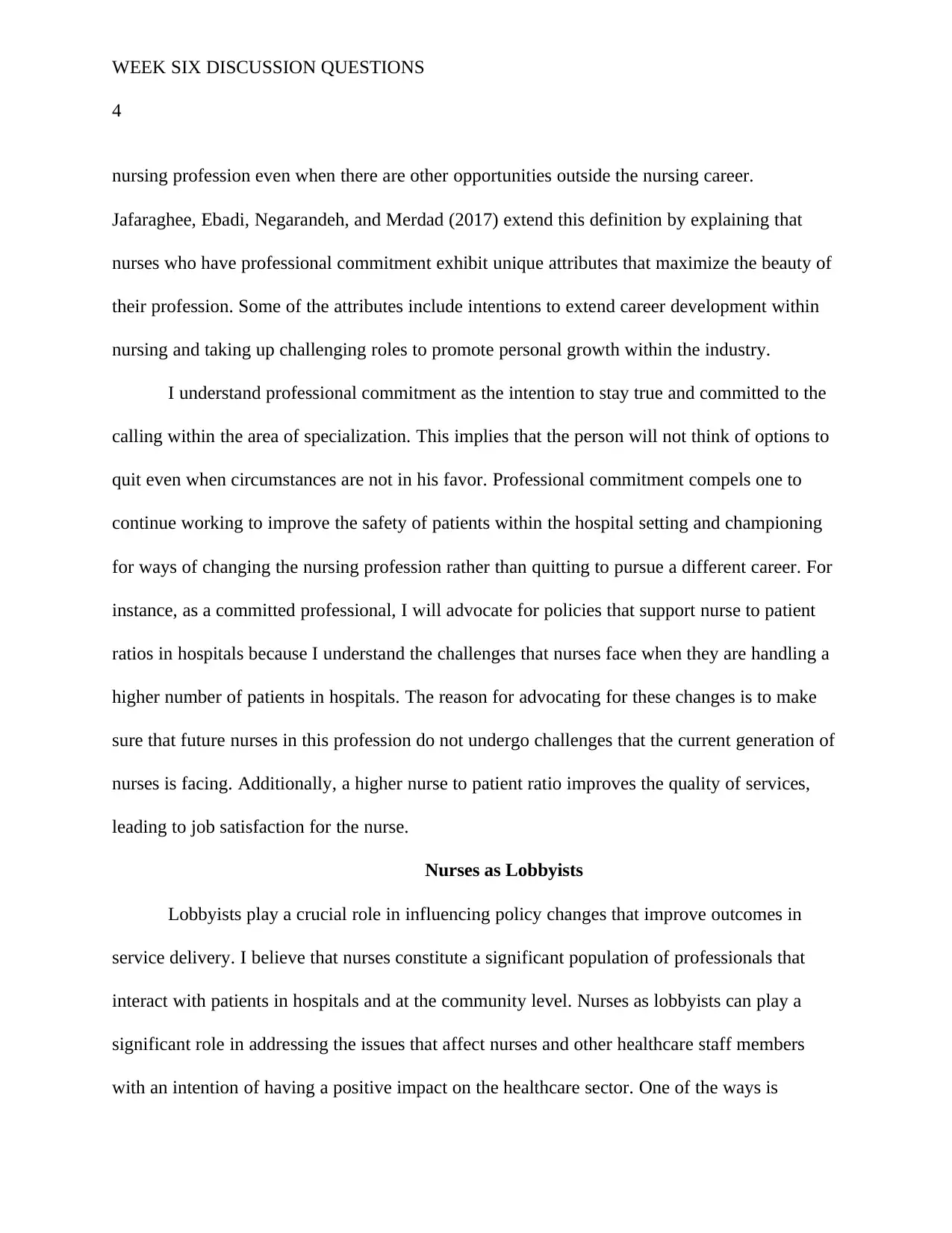
WEEK SIX DISCUSSION QUESTIONS
4
nursing profession even when there are other opportunities outside the nursing career.
Jafaraghee, Ebadi, Negarandeh, and Merdad (2017) extend this definition by explaining that
nurses who have professional commitment exhibit unique attributes that maximize the beauty of
their profession. Some of the attributes include intentions to extend career development within
nursing and taking up challenging roles to promote personal growth within the industry.
I understand professional commitment as the intention to stay true and committed to the
calling within the area of specialization. This implies that the person will not think of options to
quit even when circumstances are not in his favor. Professional commitment compels one to
continue working to improve the safety of patients within the hospital setting and championing
for ways of changing the nursing profession rather than quitting to pursue a different career. For
instance, as a committed professional, I will advocate for policies that support nurse to patient
ratios in hospitals because I understand the challenges that nurses face when they are handling a
higher number of patients in hospitals. The reason for advocating for these changes is to make
sure that future nurses in this profession do not undergo challenges that the current generation of
nurses is facing. Additionally, a higher nurse to patient ratio improves the quality of services,
leading to job satisfaction for the nurse.
Nurses as Lobbyists
Lobbyists play a crucial role in influencing policy changes that improve outcomes in
service delivery. I believe that nurses constitute a significant population of professionals that
interact with patients in hospitals and at the community level. Nurses as lobbyists can play a
significant role in addressing the issues that affect nurses and other healthcare staff members
with an intention of having a positive impact on the healthcare sector. One of the ways is
4
nursing profession even when there are other opportunities outside the nursing career.
Jafaraghee, Ebadi, Negarandeh, and Merdad (2017) extend this definition by explaining that
nurses who have professional commitment exhibit unique attributes that maximize the beauty of
their profession. Some of the attributes include intentions to extend career development within
nursing and taking up challenging roles to promote personal growth within the industry.
I understand professional commitment as the intention to stay true and committed to the
calling within the area of specialization. This implies that the person will not think of options to
quit even when circumstances are not in his favor. Professional commitment compels one to
continue working to improve the safety of patients within the hospital setting and championing
for ways of changing the nursing profession rather than quitting to pursue a different career. For
instance, as a committed professional, I will advocate for policies that support nurse to patient
ratios in hospitals because I understand the challenges that nurses face when they are handling a
higher number of patients in hospitals. The reason for advocating for these changes is to make
sure that future nurses in this profession do not undergo challenges that the current generation of
nurses is facing. Additionally, a higher nurse to patient ratio improves the quality of services,
leading to job satisfaction for the nurse.
Nurses as Lobbyists
Lobbyists play a crucial role in influencing policy changes that improve outcomes in
service delivery. I believe that nurses constitute a significant population of professionals that
interact with patients in hospitals and at the community level. Nurses as lobbyists can play a
significant role in addressing the issues that affect nurses and other healthcare staff members
with an intention of having a positive impact on the healthcare sector. One of the ways is
Paraphrase This Document
Need a fresh take? Get an instant paraphrase of this document with our AI Paraphraser
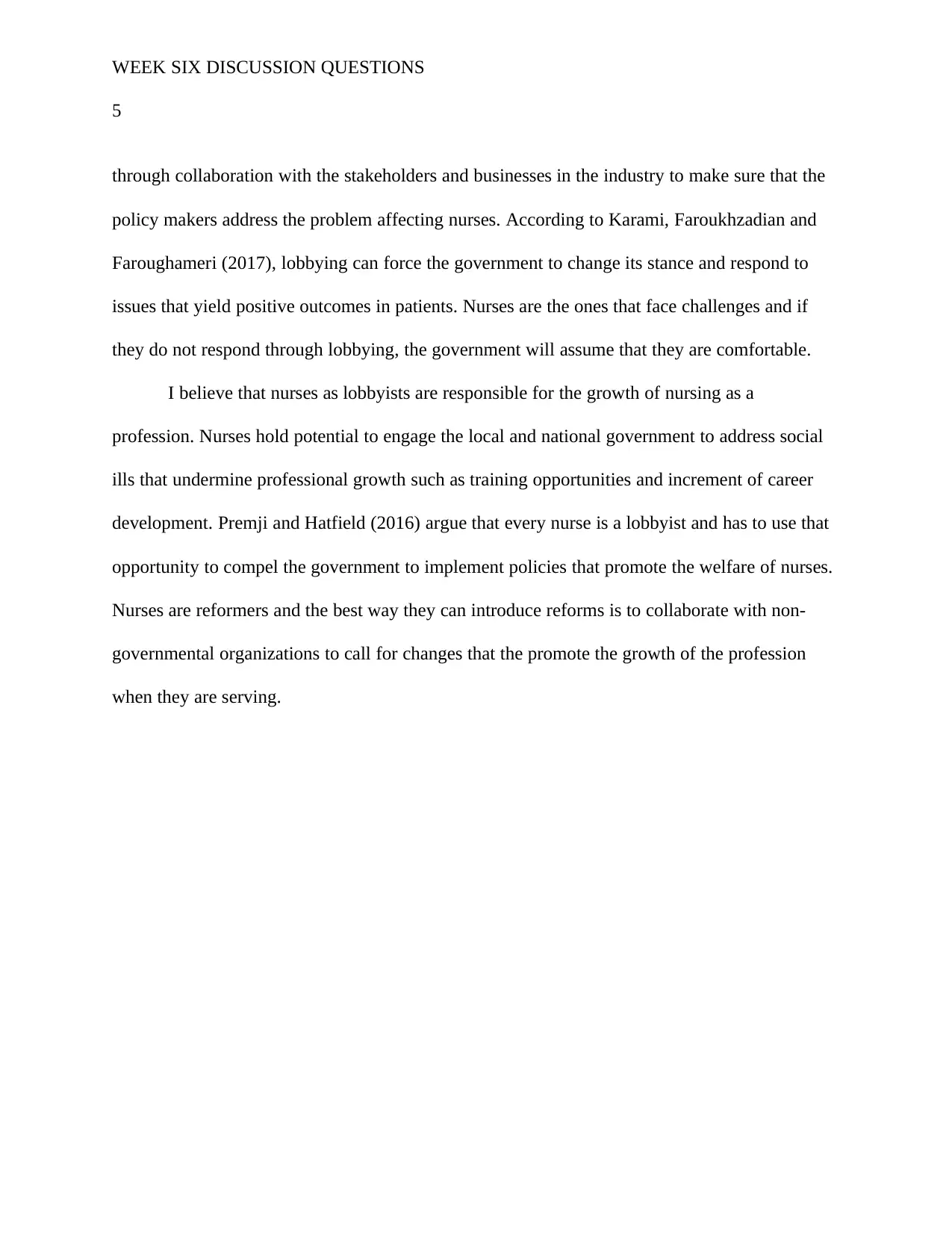
WEEK SIX DISCUSSION QUESTIONS
5
through collaboration with the stakeholders and businesses in the industry to make sure that the
policy makers address the problem affecting nurses. According to Karami, Faroukhzadian and
Faroughameri (2017), lobbying can force the government to change its stance and respond to
issues that yield positive outcomes in patients. Nurses are the ones that face challenges and if
they do not respond through lobbying, the government will assume that they are comfortable.
I believe that nurses as lobbyists are responsible for the growth of nursing as a
profession. Nurses hold potential to engage the local and national government to address social
ills that undermine professional growth such as training opportunities and increment of career
development. Premji and Hatfield (2016) argue that every nurse is a lobbyist and has to use that
opportunity to compel the government to implement policies that promote the welfare of nurses.
Nurses are reformers and the best way they can introduce reforms is to collaborate with non-
governmental organizations to call for changes that the promote the growth of the profession
when they are serving.
5
through collaboration with the stakeholders and businesses in the industry to make sure that the
policy makers address the problem affecting nurses. According to Karami, Faroukhzadian and
Faroughameri (2017), lobbying can force the government to change its stance and respond to
issues that yield positive outcomes in patients. Nurses are the ones that face challenges and if
they do not respond through lobbying, the government will assume that they are comfortable.
I believe that nurses as lobbyists are responsible for the growth of nursing as a
profession. Nurses hold potential to engage the local and national government to address social
ills that undermine professional growth such as training opportunities and increment of career
development. Premji and Hatfield (2016) argue that every nurse is a lobbyist and has to use that
opportunity to compel the government to implement policies that promote the welfare of nurses.
Nurses are reformers and the best way they can introduce reforms is to collaborate with non-
governmental organizations to call for changes that the promote the growth of the profession
when they are serving.
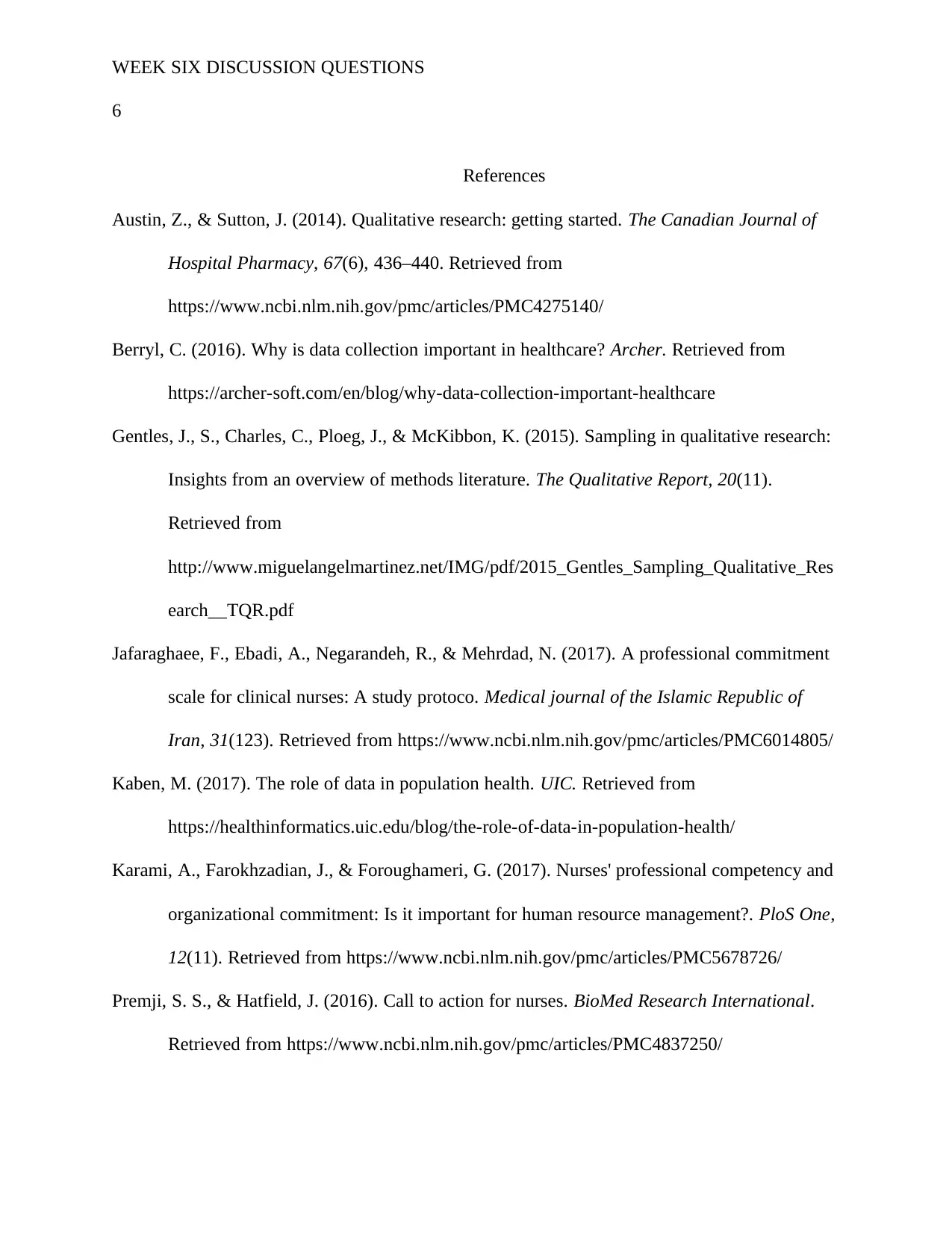
WEEK SIX DISCUSSION QUESTIONS
6
References
Austin, Z., & Sutton, J. (2014). Qualitative research: getting started. The Canadian Journal of
Hospital Pharmacy, 67(6), 436–440. Retrieved from
https://www.ncbi.nlm.nih.gov/pmc/articles/PMC4275140/
Berryl, C. (2016). Why is data collection important in healthcare? Archer. Retrieved from
https://archer-soft.com/en/blog/why-data-collection-important-healthcare
Gentles, J., S., Charles, C., Ploeg, J., & McKibbon, K. (2015). Sampling in qualitative research:
Insights from an overview of methods literature. The Qualitative Report, 20(11).
Retrieved from
http://www.miguelangelmartinez.net/IMG/pdf/2015_Gentles_Sampling_Qualitative_Res
earch__TQR.pdf
Jafaraghaee, F., Ebadi, A., Negarandeh, R., & Mehrdad, N. (2017). A professional commitment
scale for clinical nurses: A study protoco. Medical journal of the Islamic Republic of
Iran, 31(123). Retrieved from https://www.ncbi.nlm.nih.gov/pmc/articles/PMC6014805/
Kaben, M. (2017). The role of data in population health. UIC. Retrieved from
https://healthinformatics.uic.edu/blog/the-role-of-data-in-population-health/
Karami, A., Farokhzadian, J., & Foroughameri, G. (2017). Nurses' professional competency and
organizational commitment: Is it important for human resource management?. PloS One,
12(11). Retrieved from https://www.ncbi.nlm.nih.gov/pmc/articles/PMC5678726/
Premji, S. S., & Hatfield, J. (2016). Call to action for nurses. BioMed Research International.
Retrieved from https://www.ncbi.nlm.nih.gov/pmc/articles/PMC4837250/
6
References
Austin, Z., & Sutton, J. (2014). Qualitative research: getting started. The Canadian Journal of
Hospital Pharmacy, 67(6), 436–440. Retrieved from
https://www.ncbi.nlm.nih.gov/pmc/articles/PMC4275140/
Berryl, C. (2016). Why is data collection important in healthcare? Archer. Retrieved from
https://archer-soft.com/en/blog/why-data-collection-important-healthcare
Gentles, J., S., Charles, C., Ploeg, J., & McKibbon, K. (2015). Sampling in qualitative research:
Insights from an overview of methods literature. The Qualitative Report, 20(11).
Retrieved from
http://www.miguelangelmartinez.net/IMG/pdf/2015_Gentles_Sampling_Qualitative_Res
earch__TQR.pdf
Jafaraghaee, F., Ebadi, A., Negarandeh, R., & Mehrdad, N. (2017). A professional commitment
scale for clinical nurses: A study protoco. Medical journal of the Islamic Republic of
Iran, 31(123). Retrieved from https://www.ncbi.nlm.nih.gov/pmc/articles/PMC6014805/
Kaben, M. (2017). The role of data in population health. UIC. Retrieved from
https://healthinformatics.uic.edu/blog/the-role-of-data-in-population-health/
Karami, A., Farokhzadian, J., & Foroughameri, G. (2017). Nurses' professional competency and
organizational commitment: Is it important for human resource management?. PloS One,
12(11). Retrieved from https://www.ncbi.nlm.nih.gov/pmc/articles/PMC5678726/
Premji, S. S., & Hatfield, J. (2016). Call to action for nurses. BioMed Research International.
Retrieved from https://www.ncbi.nlm.nih.gov/pmc/articles/PMC4837250/
⊘ This is a preview!⊘
Do you want full access?
Subscribe today to unlock all pages.

Trusted by 1+ million students worldwide
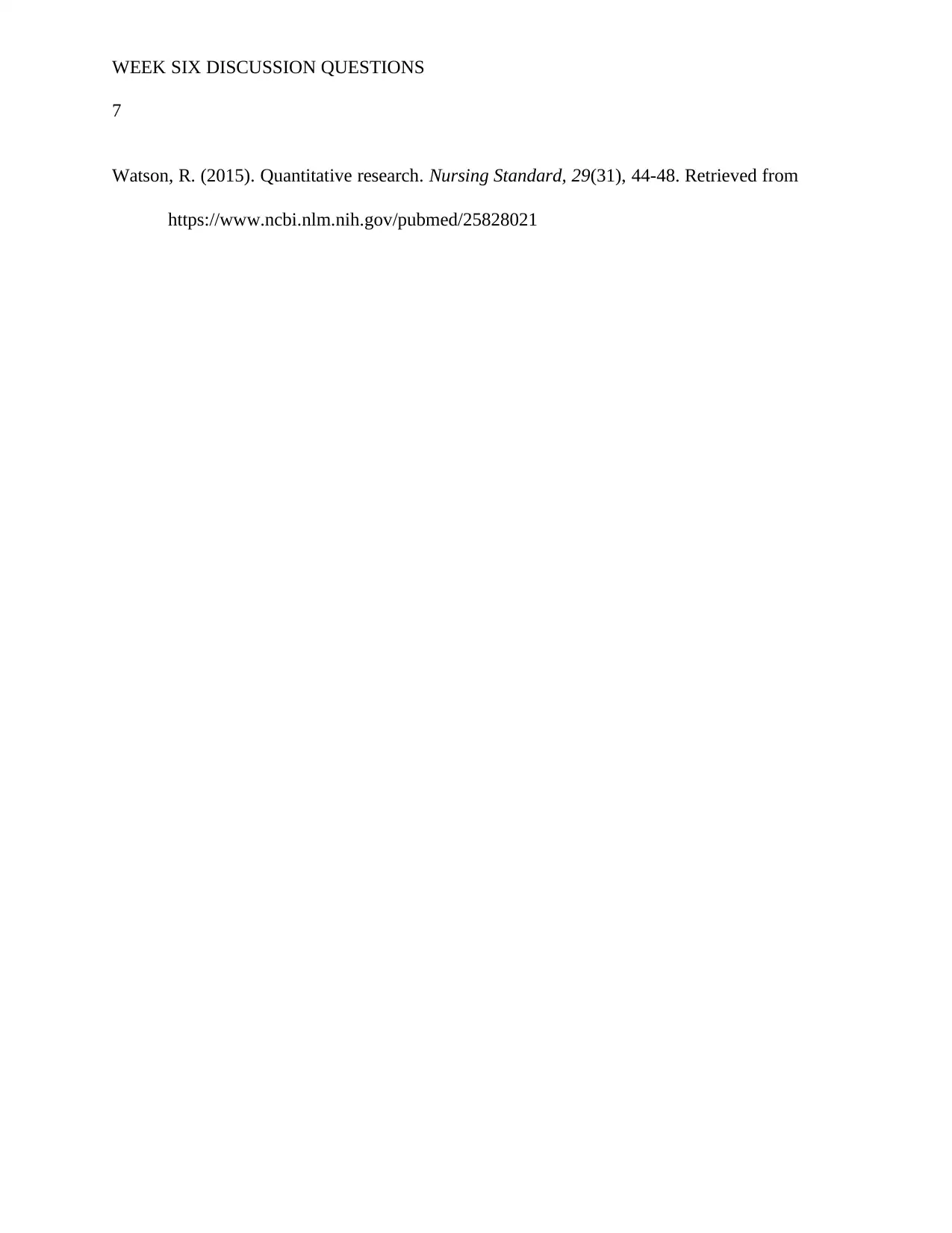
WEEK SIX DISCUSSION QUESTIONS
7
Watson, R. (2015). Quantitative research. Nursing Standard, 29(31), 44-48. Retrieved from
https://www.ncbi.nlm.nih.gov/pubmed/25828021
7
Watson, R. (2015). Quantitative research. Nursing Standard, 29(31), 44-48. Retrieved from
https://www.ncbi.nlm.nih.gov/pubmed/25828021
1 out of 7
Related Documents
Your All-in-One AI-Powered Toolkit for Academic Success.
+13062052269
info@desklib.com
Available 24*7 on WhatsApp / Email
![[object Object]](/_next/static/media/star-bottom.7253800d.svg)
Unlock your academic potential
Copyright © 2020–2025 A2Z Services. All Rights Reserved. Developed and managed by ZUCOL.





